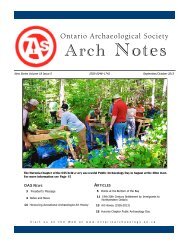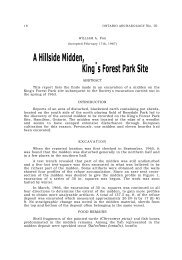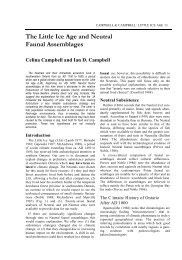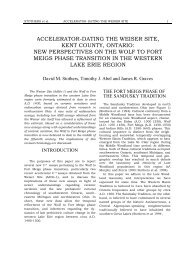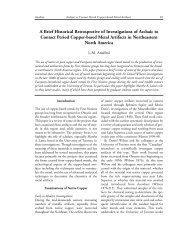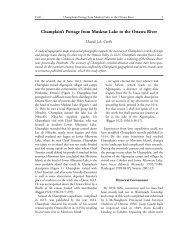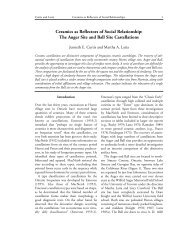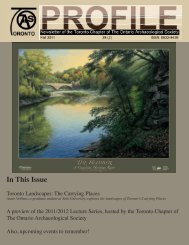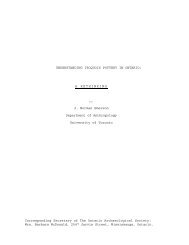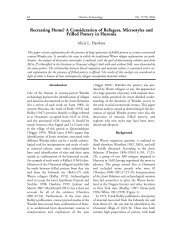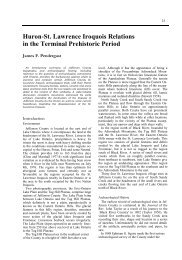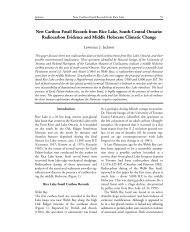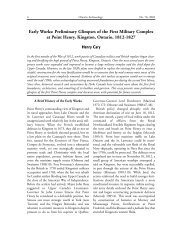oa 74 part 01 pilon layout - Ontario Archaeological Society
oa 74 part 01 pilon layout - Ontario Archaeological Society
oa 74 part 01 pilon layout - Ontario Archaeological Society
- No tags were found...
Create successful ePaper yourself
Turn your PDF publications into a flip-book with our unique Google optimized e-Paper software.
8 <strong>Ontario</strong> Archaeology No. <strong>74</strong>, 2002and the trade networks involved in obtainingvarious exotic stones, rarely is it acknowledgedthat, especially in northern latitudes, access tolithic raw materials is restricted to but a fewmonths of the year. Supplies of suitable lithicresources must therefore be carefully set aside forthose long months during which ice and snowmake their collecting virtually impossible. In thiscontext then, it is highly informative to review thecontents of the cache and some of the features ofthe objects making up this unique snapshot.The Ouissinaougouk CacheThe tools, tool blanks, flakes and lithic detritus thatcomprise the Ouissinaougouk cache (Table 1)formed a compact mound lying immediately ontop of a palm-sized piece of birch-bark (althoughthere were a few specimens beneath this bark),within a slight depression (see the middle image ofFigure 5). This group of objects was recovered fromwithin a dark, organic layer measuring 2 to 3 cm inthickness, lying approximately 20-30 cm below thecurrent surface, under a succession of alternatinghumus and overbank sand/silt deposits (Figures 4and 5). Nearby, in this same test unit, some calcinedbone fragments, scattered pieces of charc<strong>oa</strong>l andfire-cracked rocks were found within the samestratigraphic level as the cache and suggested proximityto a hearth feature. Within the area of thecache, the humic matrix appeared darker andTable 1. Ouissinaougouk artifacts.Artifact TypeFrequencyProjectile Points 1Bifaces 3Pièces esquillées 1 4Gravers/perforators 4Core Remnants 2Scrapers 2 62Notches 3 5Retouched/Used flakes 13Flakes 249Total 3431 does not include one made on a scraper2 includes one also used as a pièce esquillée and another thathas a notch3 does not include a scraper with a notch“greasier” than the surrounding humus of this level.As luck would have it, the cluster of stone toolsand debitage was neatly bisected by the wall of theinitial 50 cm x 50 cm test unit, which was laterexpanded in order to fully encompass the cache.I interpret the association of the cluster of lithicspecimens with the birch-bark fragment to indicatethat the 343 pieces of stone had originally been ina birch-bark container (possibly propped upagainst a long stone slab measuring approximately30 cm x 10 cm x 5 cm), which had subsequentlyand slowly collapsed, and eventually been coveredover with silt from floodwaters of the Ouissinaouand Sachigo Rivers. This collection thus representsa single moment in time, a very intentional gatheringof stone tools.The stratigraphic context of the Ouissinaougoukcache, as well as the overwhelming nature of thephysical association of its elements, leave no doubtthat these were objects intended to be kept togetherby their former owner and available for his orher use. As such, we are afforded the unique opportunityof examining and describing associationsbetween different artifact categories and a seasonal,activity-specific site.In attempting to assess the significance of varioustypes or classes of tools, the relative proportionsmust somehow be comparable. This task ismade very difficult when site collections are comprisedof whole, near-complete and fragmentaryimplements. Creative methods have been proposedto rectify and properly account for the presence ofincomplete and fragmentary implements (Shott2000). In the example presented here, such manipulationis not necessary as all of the tools are whole.Ouissinaougouk Cache ContentsProjectile Point (Figure 6a)Only one projectile point was found among the343 items comprising the cache. This point wascarefully thinned and retouched bifacially,although it is proportionately thick. Overall, thepoint’s shape is an isosceles triangle with a slightlyconvex base, low side-notches and straight to verylightly convex blade edges. The tip is somewhatrounded as a result of possible resharpening on oneside. The maximum dimensions are 4.8 cm x 2.6



